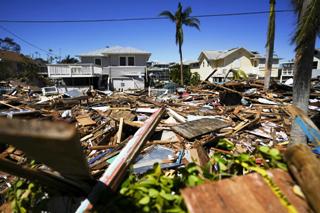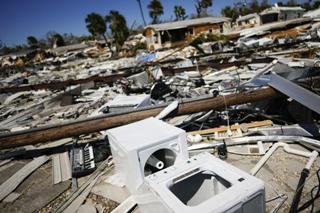|
Ian deals blow to Florida’s teetering insurance
sector |
Article Courtesy of AP NEWS
By By DEE-ANN DURBIN and ANNE D'INNOCENZIO
Published
October 8, 2022
Daniel Kelly and his wife bought a 1977 doublewide
mobile home in May for about $83,000 at Tropicana Sands, a community for
people 55 and older in Fort Myers, Florida. But he ran into roadblocks
when he tried to insure it.
|
Managers at Tropicana Sands told him he
likely wouldn’t be able to find a carrier who would offer a
policy because the home was too old. He said he checked with
a Florida-based insurance agent who searched and couldn’t
find anything.
“I can insure a 1940s car, why can’t I insure this?” Kelly
said.
Kelly was lucky that his trailer was largely spared by
Hurricane Ian aside from some flood damage. But for many
Floridians whose homes were destroyed, they now face the
arduous task of rebuilding without insurance or paying even
steeper prices in an insurance market that was already
struggling. Wind and storm-surge losses from the hurricane
could reach between $28 billion and $47 billion, making it
Florida’s costliest storm since Hurricane Andrew made
landfall in 1992, according to the property analytics firm
CoreLogic.
Even before Ian, Florida’s home insurance market was dealing
with billions of dollars in losses from a string of natural
disasters, rampant litigation and increasing fraud. The
difficult environment has put many insurers out of business
and caused others to raise their prices or tighten their
restrictions, making it harder for Floridians to obtain
insurance.
Daniel Kelly and his wife bought a 1977 doublewide mobile
home in May for about $83,000 at Tropicana Sands, a
community for people 55 and older in Fort Myers, Florida.
But he ran into roadblocks when he tried to insure it.
|
|
A road is completely filled with a tall pile of
debris from destroyed beachfront homes and businesses, two days
after the passage of Hurricane Ian, in Fort Myers Beach, Fla., Sept.
30, 2022. Florida's home insurance market was already on shaky
ground. It now faces an even mightier struggle after the damage
caused by the hurricane.
|
Managers at Tropicana Sands told him he
likely wouldn’t be able to find a carrier who would offer a
policy because the home was too old. He said he checked with
a Florida-based insurance agent who searched and couldn’t
find anything.
“I can insure a 1940s car, why can’t I insure this?” Kelly
said.
|
Kelly was lucky that his trailer was
largely spared by Hurricane Ian aside from some flood
damage. But for many Floridians whose homes were destroyed,
they now face the arduous task of rebuilding without
insurance or paying even steeper prices in an insurance
market that was already struggling. Wind and storm-surge
losses from the hurricane could reach between $28 billion
and $47 billion, making it Florida’s costliest storm since
Hurricane Andrew made landfall in 1992, according to the
property analytics firm CoreLogic.
Even before Ian, Florida’s home insurance market was dealing
with billions of dollars in losses from a string of natural
disasters, rampant litigation and increasing fraud. The
difficult environment has put many insurers out of business
and caused others to raise their prices or tighten their
restrictions, making it harder for Floridians to obtain
insurance.
Those who do manage to insure their homes are seeing costs
increase exponentially. Even before Hurricane Ian, the
annual cost of an average Florida homeowners insurance
policy was expected to reach $4,231 in 2022, nearly three
times the U.S. average of $1,544.
“They are paying more for less coverage,” said Florida’s
Insurance Consumer Advocate Tasha Carter. “It puts consumers
in dire circumstances.”
The costs have gotten so high that some homeowners have
forgone coverage altogether. About 12% of Florida homeowners
don’t have property insurance — or more than double the U.S.
average of 5% — according to the Insurance Information
Institute, a research organization funded by the insurance
industry.
|
|
Household belongings and debris lie scattered in a
trailer park, two days after the passage of Hurricane Ian, in Fort
Myers Beach, Fla., Sept. 30, 2022. Florida's home insurance market
was already on shaky ground. It now faces an even mightier struggle
after the damage caused by the hurricane.
|
Florida’s insurance industry has seen two straight
years of net underwriting losses exceeding $1 billion each year. A
string of property insurers, including six so far this year, have become
insolvent, while others are leaving the state.
As of July, 27 Florida insurers were on a state watchlist for their
precarious financial situation; Mark Friedlander, the head of
communications for the Insurance Information Institute, expects
Hurricane Ian will cause at least some of those to tip into insolvency.
The insurance industry says overzealous litigation is partly to blame.
Loopholes in Florida law, including fee multipliers that allow attorneys
to collect higher fees for property insurance cases, have made Florida
an excessively litigious state, Friedlander said.
Florida currently averages about 100,000 lawsuits over homeowners’
insurance claims per year, he said. That compares to just 3,600 in
California, which has almost double Florida’s population.
The Florida Office of Insurance Regulation said the state accounts for
76% of the nation’s homeowners’ insurance claims lawsuits but just 9% of
all homeowners insurance claims.
“Plaintiff attorneys in Florida have historically found ways of
circumventing any efforts at reining in legal system abuses, making it
likely that ongoing reforms will be needed to further stabilize the
insurance marketplace,” said Logan McFaddin of the American Property
Casualty Insurance Association.
But Amy Boggs, the property section chair for the Florida Justice
Association — a group that represents attorneys — said the insurance
industry is also at fault for refusing to pay out claims. Boggs said
homeowners are driven to attorneys “as a last resort.”
“No policyholder wants to be embroiled in years of litigation just to
get their homes rebuilt,” she said. “They come to attorneys when their
insurance company underpays their claim and they can’t rebuild.”
Rampant fraud — particularly among roofing contractors — has also added
to costs. Regulators say it’s common for contractors to go door-to-door
offering to cover homeowners’ insurance deductible in exchange for
submitting a full roof replacement claim to their property insurance
company, claiming damage from storms.
Things have gotten so bad with insurance that Florida Gov. Ron DeSantis
called a special session in May to address the issues. New laws limit
the rates attorneys can charge for some property insurance claims and
require insurers to insure homes with older roofs — something they had
stopped doing because of rising fraud claims.
The legislation also includes a $150 million fund that will offer grants
to homeowners to make improvements to protect against hurricanes. But
that program has yet to be launched, and experts say it will take years
to reverse the damage to Florida’s insurance market.
In the meantime, the crisis has pushed more homeowners to Citizens
Property Insurance Corp., the state-backed insurer that sells home
insurance for those who can’t get coverage through private insurers.
Citizens had more than 1 million active policies as of Sept. 23, before
Ian hit, according to Michael Peltier, a spokesman at Citizens. In 2019,
that number was roughly 420,000. He said the company had been writing
8,000 to 9,000 new policies per week, double compared with a few years
ago. Citizens has $13.4 billion in reserves and predicts it will pay
225,000 claims from Ian worth a total of $3.7 billion.
Even if they have homeowners’ insurance, many Floridians could still be
facing financial ruin because of flooding. Flood damage isn’t typically
covered by homeowners’ insurance but can be costly; Florida’s Division
of Emergency Management says 1 inch of floodwater can do $25,000 in
damage.
Friedlander said just 18% of Florida homeowners carry flood insurance,
either through the federal government’s National Flood Insurance Program
or private insurers. In some coastal areas, more than half of homeowners
have flood insurance, but in inland areas — where flood waters continued
to rise even after the storm had passed — it’s closer to 5%.
Kelly, whose trailer in Fort Myers was saturated in 4 feet of salt water
and sewage after Hurricane Ian, could have benefitted from flood
insurance. He thought he might not be able to get it because he didn’t
have homeowners insurance, but that’s not the case — flood insurance is
completely separate and can even be purchased by renters, experts say.
“I kinda let it lie when I originally couldn’t find someone to insure
it,” he said. “It’s a costly oversight on my part.”
|

